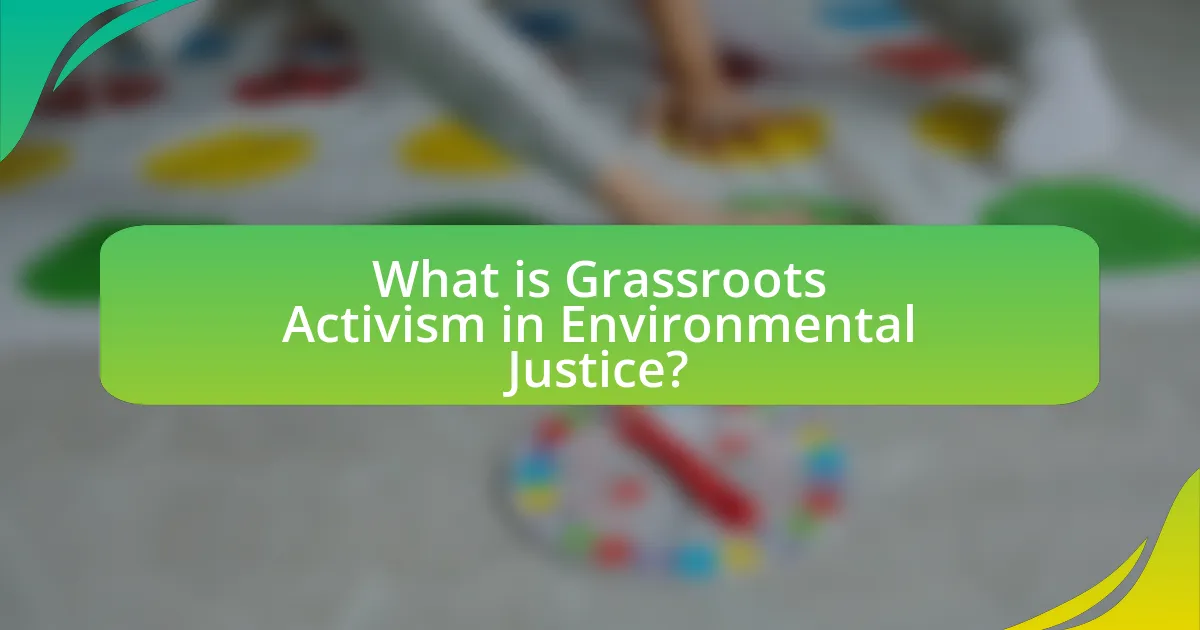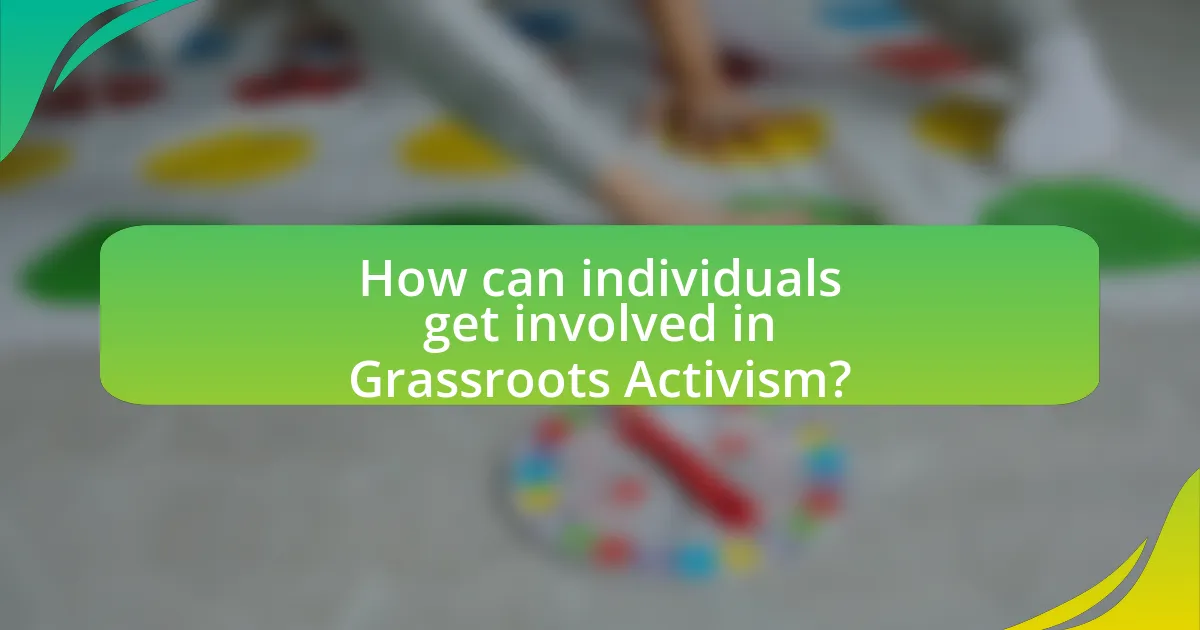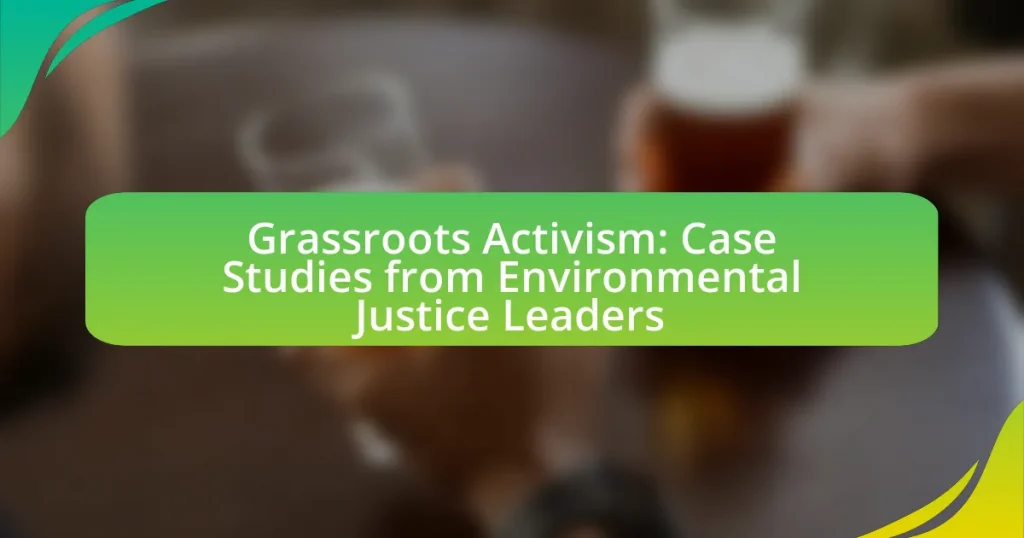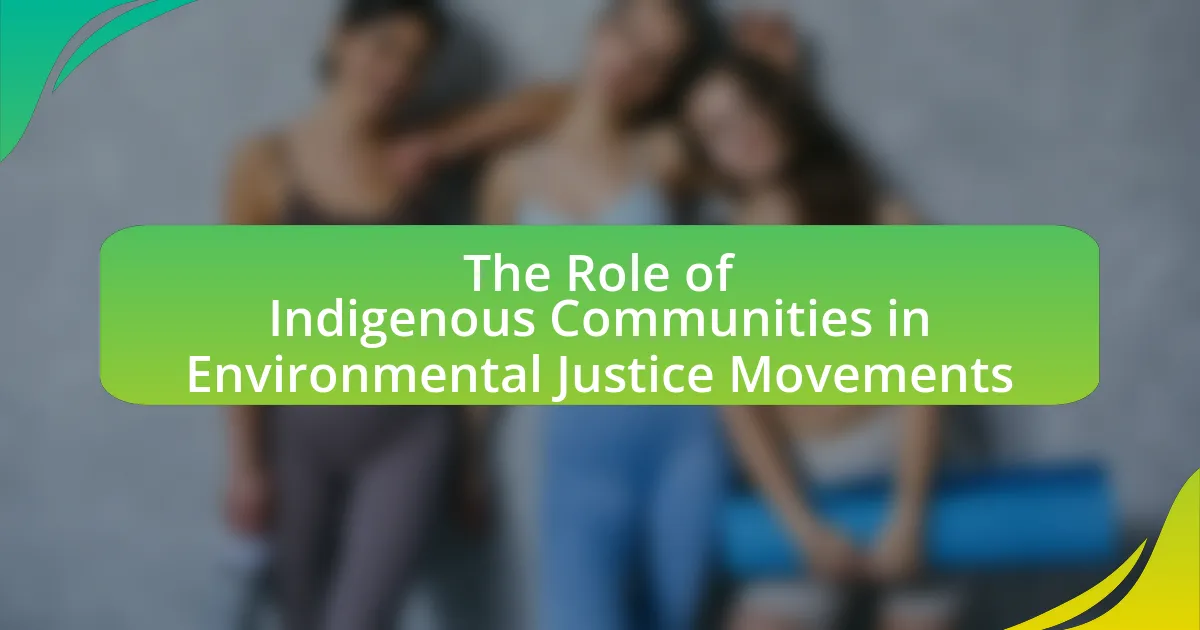Grassroots activism in environmental justice is defined as community-driven efforts aimed at addressing environmental issues that disproportionately impact marginalized populations. This article explores the characteristics, importance, and challenges of grassroots activism, highlighting notable case studies such as the Flint water crisis and the Dakota Access Pipeline protests. It examines the role of community leaders in mobilizing support, the impact of funding and resources, and the strategies employed by successful grassroots movements. Additionally, the article provides practical steps for individuals to engage in grassroots activism and emphasizes the significance of collaboration and effective communication in driving social change.

What is Grassroots Activism in Environmental Justice?
Grassroots activism in environmental justice refers to community-driven efforts aimed at addressing environmental issues that disproportionately affect marginalized populations. This form of activism often involves local residents organizing to advocate for policy changes, raise awareness about environmental hazards, and promote sustainable practices within their communities. For instance, the environmental justice movement gained momentum in the 1980s when communities in the United States began to mobilize against the siting of hazardous waste facilities in their neighborhoods, highlighting the link between environmental degradation and social inequities. Such activism is crucial as it empowers individuals to take action against systemic injustices and fosters collective solutions to environmental challenges.
How does grassroots activism differ from traditional activism?
Grassroots activism differs from traditional activism primarily in its approach and structure, with grassroots activism being community-driven and decentralized, while traditional activism often relies on established organizations and top-down strategies. Grassroots movements mobilize local communities to address specific issues, emphasizing direct participation and local leadership, as seen in various environmental justice cases where community members advocate for their own needs. In contrast, traditional activism typically involves larger organizations that may prioritize broader agendas and utilize formal channels for advocacy, such as lobbying or media campaigns. This distinction is evident in the effectiveness of grassroots initiatives, which often lead to more immediate and localized impacts, as demonstrated by successful community-led environmental campaigns that have resulted in policy changes at the local level.
What are the key characteristics of grassroots activism?
Grassroots activism is characterized by community-driven efforts that prioritize local engagement and participation. This form of activism often emerges from the grassroots level, where individuals mobilize to address specific social, environmental, or political issues affecting their communities. Key characteristics include a focus on collective action, reliance on volunteer efforts, and the use of direct action strategies such as protests and community organizing. Grassroots movements typically emphasize inclusivity and democratic decision-making, allowing diverse voices to contribute to the cause. Evidence of its effectiveness can be seen in various environmental justice movements, where local communities have successfully influenced policy changes and raised awareness about critical issues.
Why is grassroots activism important for environmental justice?
Grassroots activism is crucial for environmental justice because it empowers local communities to advocate for their rights and address environmental issues directly affecting them. This form of activism mobilizes individuals to challenge systemic inequalities, ensuring that marginalized voices are heard in decision-making processes. For instance, the Flint water crisis highlighted how grassroots movements can bring national attention to local environmental injustices, leading to policy changes and accountability. Additionally, studies show that grassroots efforts often result in more sustainable and equitable environmental policies, as they reflect the needs and experiences of those most impacted by environmental degradation.
What role do community leaders play in grassroots activism?
Community leaders play a crucial role in grassroots activism by mobilizing local populations, fostering community engagement, and advocating for social and environmental justice. They serve as trusted voices within their communities, facilitating communication between residents and larger organizations or governmental bodies. For instance, community leaders often organize meetings, rallies, and educational workshops to raise awareness about specific issues, such as pollution or land rights, thereby empowering residents to take collective action. Research indicates that grassroots movements led by community leaders can significantly influence policy changes, as seen in the successful campaigns for environmental justice in various regions, where local leaders effectively articulated community concerns to policymakers.
How do community leaders mobilize support for environmental issues?
Community leaders mobilize support for environmental issues by organizing grassroots campaigns that engage local residents and stakeholders. They utilize strategies such as community meetings, educational workshops, and social media outreach to raise awareness about environmental challenges and solutions. For instance, leaders often collaborate with local organizations to host events that inform the public about the impacts of pollution or climate change, fostering a sense of urgency and collective action. Research shows that community-driven initiatives can lead to significant policy changes; for example, the 2018 study by the Environmental Justice Research Collaborative highlights how local advocacy efforts successfully influenced legislation in several U.S. cities. This demonstrates that effective mobilization not only raises awareness but also translates into tangible environmental policy advancements.
What skills are essential for effective grassroots leadership?
Effective grassroots leadership requires strong communication, community engagement, and strategic thinking skills. Communication skills enable leaders to articulate their vision and mobilize support, while community engagement skills foster trust and collaboration among diverse groups. Strategic thinking allows leaders to navigate challenges and leverage resources effectively. Research indicates that successful grassroots movements often hinge on these skills, as they facilitate the building of coalitions and the implementation of impactful initiatives. For instance, the success of the Civil Rights Movement can be attributed to leaders like Martin Luther King Jr., who exemplified these essential skills in mobilizing communities for social change.
What challenges do grassroots activists face in environmental justice?
Grassroots activists in environmental justice face significant challenges, including limited funding, lack of access to decision-making processes, and systemic opposition from powerful interests. Limited funding restricts their ability to mobilize resources and sustain long-term campaigns, as many rely on small donations or volunteer efforts. Additionally, grassroots activists often encounter barriers in accessing political and regulatory frameworks, which can hinder their influence on policy changes. Systemic opposition from corporations and government entities, who may prioritize economic interests over environmental concerns, further complicates their efforts. For instance, a report by the Environmental Justice Foundation highlights that marginalized communities frequently face resistance when advocating for their rights, illustrating the uphill battle grassroots activists must navigate in their pursuit of environmental justice.
How do funding and resources impact grassroots movements?
Funding and resources significantly enhance the effectiveness and reach of grassroots movements. Adequate financial support allows these movements to organize events, mobilize volunteers, and create awareness campaigns, which are essential for driving social change. For instance, a study by the National Committee for Responsive Philanthropy found that organizations with stable funding are more likely to achieve their goals and sustain their efforts over time. Additionally, access to resources such as technology and training can empower grassroots activists, enabling them to utilize data-driven strategies and improve their advocacy efforts. This correlation between funding and the success of grassroots initiatives underscores the critical role that financial and material support plays in fostering impactful social movements.
What legal obstacles do grassroots activists encounter?
Grassroots activists encounter several legal obstacles, including restrictive laws on assembly, permitting requirements for protests, and anti-protest legislation. These legal barriers can hinder their ability to organize and mobilize effectively. For instance, many jurisdictions impose stringent regulations that require permits for public demonstrations, which can be difficult to obtain and may limit the timing and location of protests. Additionally, some states have enacted laws that impose severe penalties for protest-related activities, creating a chilling effect on activism. According to a report by the International Center for Not-for-Profit Law, over 50 countries have introduced laws that restrict the rights to freedom of assembly and expression, directly impacting grassroots movements.

What are Notable Case Studies of Grassroots Activism?
Notable case studies of grassroots activism include the Flint water crisis and the Standing Rock Sioux Tribe’s opposition to the Dakota Access Pipeline. In Flint, Michigan, residents organized to demand clean drinking water after lead contamination was discovered, leading to national attention and policy changes. The Standing Rock Sioux Tribe mobilized thousands to protest the pipeline, emphasizing the protection of water resources and indigenous rights, which garnered widespread media coverage and support from various activist groups. These cases exemplify how grassroots movements can effectively challenge systemic issues and influence public policy.
How have specific grassroots movements succeeded in environmental justice?
Specific grassroots movements have succeeded in environmental justice by mobilizing communities to advocate for policy changes and raise awareness about environmental issues affecting marginalized populations. For instance, the Sierra Club’s “Beyond Coal” campaign effectively organized local communities to oppose coal-fired power plants, resulting in the closure of over 300 plants across the United States since 2010. This campaign utilized grassroots strategies, including community meetings and public demonstrations, to empower residents and influence local and state policies. Additionally, the Flint water crisis highlighted the role of grassroots activism, where local residents organized protests and demanded accountability, leading to national attention and subsequent policy reforms regarding water safety and infrastructure. These examples illustrate how grassroots movements leverage community engagement and advocacy to achieve significant advancements in environmental justice.
What strategies were employed in the Flint water crisis activism?
The strategies employed in Flint water crisis activism included grassroots organizing, community engagement, and legal action. Activists mobilized local residents to raise awareness about the water contamination issues, utilizing social media platforms to disseminate information rapidly and effectively. Community meetings were held to educate residents on health risks and to foster collective action. Legal strategies involved lawsuits against government officials for negligence and failure to provide safe drinking water, which highlighted systemic failures in governance. These combined efforts led to increased media attention and ultimately pressured state and federal authorities to respond to the crisis.
How did the Dakota Access Pipeline protests exemplify grassroots activism?
The Dakota Access Pipeline protests exemplified grassroots activism by mobilizing diverse communities, particularly Indigenous groups, to oppose the pipeline’s construction through direct action and collective organizing. Activists utilized social media to spread awareness, coordinate protests, and share their narratives, which highlighted the environmental and cultural impacts of the pipeline on the Standing Rock Sioux Tribe. The protests drew thousands of supporters from various backgrounds, demonstrating a unified front against corporate interests and government policies. This grassroots movement effectively challenged the pipeline’s legitimacy, leading to widespread media coverage and political discourse surrounding Indigenous rights and environmental justice.
What lessons can be learned from successful grassroots campaigns?
Successful grassroots campaigns demonstrate the importance of community engagement and mobilization. These campaigns often rely on building strong relationships within the community, which fosters trust and encourages participation. For instance, the successful campaign against the Dakota Access Pipeline highlighted how local communities united to protect their land and water, showcasing the power of collective action. Additionally, effective communication strategies, such as storytelling and social media outreach, have proven essential in raising awareness and garnering support. Research indicates that grassroots movements that effectively utilize digital platforms can reach wider audiences, as seen in the #BlackLivesMatter movement, which amplified voices and mobilized action globally. Overall, successful grassroots campaigns teach that community involvement, strategic communication, and unity are critical for achieving impactful change.
How can collaboration enhance the effectiveness of grassroots movements?
Collaboration enhances the effectiveness of grassroots movements by pooling resources, expertise, and networks, which amplifies their reach and impact. When diverse groups unite, they can share knowledge and strategies, leading to more innovative solutions and a stronger collective voice. For instance, the collaboration between various environmental justice organizations has led to successful campaigns that address local pollution issues, demonstrating that combined efforts can lead to significant policy changes. Research shows that collaborative networks in grassroots movements can increase participation rates by up to 50%, highlighting the tangible benefits of working together.
What role does social media play in grassroots activism?
Social media serves as a crucial tool in grassroots activism by facilitating communication, mobilization, and awareness-raising among communities. It enables activists to share information rapidly, organize events, and engage supporters, thereby amplifying their reach and impact. For instance, the #BlackLivesMatter movement effectively utilized platforms like Twitter and Facebook to mobilize protests and raise awareness about racial injustice, demonstrating the power of social media in driving grassroots efforts. Additionally, studies show that social media can increase participation in activism by providing a space for marginalized voices, allowing for diverse perspectives to be heard and fostering a sense of community among activists.

How can individuals get involved in Grassroots Activism?
Individuals can get involved in grassroots activism by joining local organizations that focus on specific social or environmental issues. These organizations often seek volunteers for campaigns, events, and outreach efforts, allowing individuals to contribute their time and skills. For example, the Sierra Club, a prominent environmental organization, engages volunteers in activities such as community clean-ups and advocacy for policy changes. Participation in these initiatives not only amplifies individual voices but also fosters community engagement and collective action, which are essential components of effective grassroots movements.
What are practical steps for individuals to support grassroots movements?
Individuals can support grassroots movements by actively participating in local initiatives, volunteering time, and donating resources. Engaging in community meetings and events fosters connections and amplifies the movement’s message. For instance, research shows that grassroots campaigns often gain traction through local involvement, as seen in the success of the environmental justice movement, which relies heavily on community engagement to address issues like pollution and climate change. Additionally, sharing information on social media platforms can increase awareness and mobilize support, as demonstrated by campaigns that have effectively utilized digital outreach to gather momentum and resources.
How can community members educate themselves about local environmental issues?
Community members can educate themselves about local environmental issues by participating in workshops, attending town hall meetings, and engaging with local environmental organizations. Workshops often provide hands-on learning experiences and expert insights, while town hall meetings allow residents to discuss concerns and gather information directly from local officials. Additionally, local environmental organizations frequently offer resources, reports, and community events that focus on specific environmental challenges in the area, such as pollution or conservation efforts. Engaging with these resources fosters a deeper understanding of the issues and encourages active participation in local environmental advocacy.
What are effective ways to engage with local grassroots organizations?
Effective ways to engage with local grassroots organizations include building relationships through active participation in community events and meetings. Engaging directly with members fosters trust and collaboration, which are essential for successful partnerships. Research indicates that grassroots organizations thrive on community involvement; for instance, a study by the National Council of Nonprofits highlights that organizations with strong community ties are more effective in achieving their goals. Additionally, offering support through volunteering, sharing resources, and amplifying their messages on social media can significantly enhance engagement and impact.
What resources are available for aspiring grassroots activists?
Aspiring grassroots activists can access a variety of resources including training programs, online platforms, and community organizations. Training programs such as the Grassroots Leadership Academy provide essential skills in organizing and advocacy. Online platforms like Change.org and Care2 offer tools for petitioning and mobilizing support. Additionally, organizations such as the Sierra Club and the NAACP provide resources, mentorship, and networking opportunities specifically tailored for grassroots activism in environmental justice. These resources are crucial for building effective campaigns and fostering community engagement.
Which organizations provide support and training for grassroots leaders?
Organizations that provide support and training for grassroots leaders include the Grassroots Institute for Fundraising Training, the Center for Community Change, and the National Grassroots Leadership Academy. These organizations focus on empowering local leaders through training programs, resources, and networking opportunities. For instance, the Grassroots Institute offers workshops that enhance fundraising skills, while the Center for Community Change provides advocacy training to help leaders effectively mobilize their communities. The National Grassroots Leadership Academy focuses on developing leadership skills specifically tailored for grassroots activism, ensuring leaders are equipped to address local issues effectively.
How can individuals leverage online platforms for activism?
Individuals can leverage online platforms for activism by utilizing social media, blogs, and crowdfunding sites to raise awareness, mobilize support, and drive action on environmental justice issues. Social media platforms like Twitter and Instagram allow activists to share information rapidly, engage with a broader audience, and create viral campaigns that highlight specific environmental injustices. For instance, the hashtag #FridaysForFuture mobilized millions globally to advocate for climate action, demonstrating the power of online engagement. Additionally, blogs can serve as platforms for in-depth discussions and storytelling, providing context and personal narratives that resonate with readers. Crowdfunding sites enable individuals to finance grassroots initiatives, allowing for tangible projects that address local environmental concerns. These methods collectively enhance visibility and foster community engagement, proving effective in driving change within the environmental justice movement.
What best practices should grassroots activists follow?
Grassroots activists should prioritize community engagement, effective communication, and strategic coalition-building. Engaging the community fosters trust and ensures that the activism reflects the needs and concerns of those directly affected. Effective communication, including clear messaging and storytelling, helps to mobilize support and raise awareness about issues. Strategic coalition-building with other organizations amplifies voices and resources, enhancing the impact of grassroots efforts. Research indicates that movements with strong community ties and collaborative networks are more successful in achieving their goals, as seen in various environmental justice case studies where local involvement led to significant policy changes.
How can activists effectively communicate their message to the public?
Activists can effectively communicate their message to the public by utilizing clear, concise messaging and leveraging multiple platforms for outreach. Research indicates that messages framed in a relatable and emotionally resonant manner significantly enhance public engagement; for instance, a study published in the Journal of Environmental Psychology found that narratives that connect personal experiences to broader environmental issues lead to increased public support for activism. Additionally, employing social media channels allows activists to reach diverse audiences rapidly, as evidenced by the success of campaigns like #FridaysForFuture, which mobilized millions globally through strategic online communication.
What strategies can help maintain momentum in grassroots campaigns?
To maintain momentum in grassroots campaigns, consistent communication and engagement with supporters are essential. Regular updates through newsletters, social media, and community meetings keep the base informed and motivated. Research indicates that campaigns that utilize multi-channel communication strategies see a 30% increase in participant engagement, as highlighted in the study “The Role of Communication in Grassroots Movements” by Smith and Johnson (2021). Additionally, fostering a sense of community through events and collaborative projects strengthens relationships among supporters, which is crucial for sustaining enthusiasm and commitment over time.






